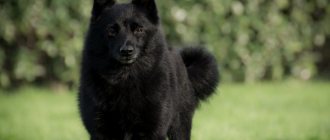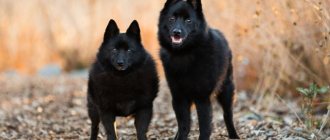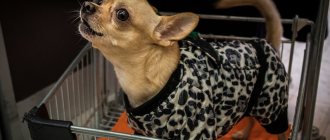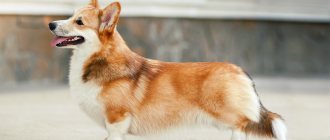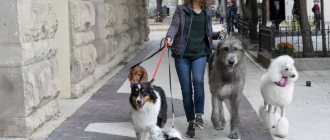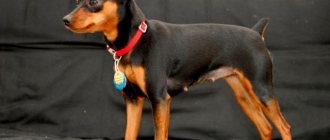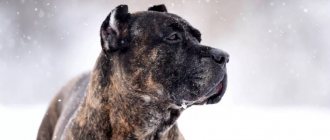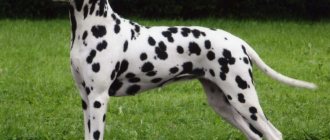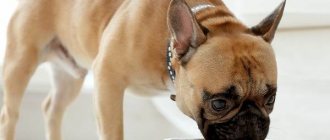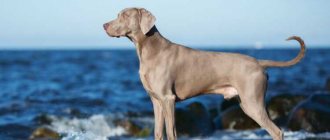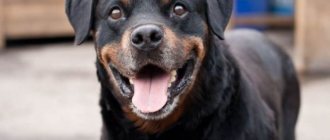| Origin: | Belgium |
| Usage: | Herding, guard, companion dog |
| Color: | Black |
| Dimensions: | Weight up to 9 kg, height at withers 20-23 cm |
| Lifespan: | up to 15 years |
Schipperke (schipperke) - the smallest shepherd dogs bred in Belgium, belong to the group of herding dogs. The funny appearance of the dog will not leave anyone indifferent to its person. Behind the plush toy appearance lies the character of a real shepherd. The Schipperke dog breed is popular in European countries and the USA. In our country it has not yet received wide recognition and popularity. Many people, seeing a photo of a Schipperke dog, confuse it with a simple mongrel.
Breed standard
The Mini Schipperke Shepherd is an organically built, stocky dog. A distinctive feature is the luxurious black wool. Males are slightly larger than females. The breed standard allows an adult weight of 4 to 7 kg.
| Options | Description of the breed |
| Head | Wedge-shaped. The transition between forehead and muzzle is not clearly defined. |
| Frame | The back is straight, without bending. The withers are very pronounced due to the thick coat. The front part of the chest, when viewed from the side, is pushed forward. |
| Head | The proportional size of the head relative to the body, in the shape of a wedge. |
| Muzzle | Narrow, equal to the length of the head. |
| Neck | Strong, muscular. Looks voluminous thanks to the frill collar. |
| Ears | Straight, erect ears in the shape of a small isosceles triangle. Located almost on the top of the head. |
| Eyes | Medium-sized, almond-shaped eyes of dark brown color. |
| Bite | A scissors bite, a straight bite is allowed as a standard. |
| Cheekbones | Smoothed, gently merging into the sides of the muzzle. |
| Lips | They fit tightly and have a clear black outline. |
| Nose | The nasal mirror is black. |
| Color | Black. |
| Wool | Straight, hard, dense coat with well-developed undercoat |
| Tail | Set high, curls upward. In some countries, a short tail (docked) or no tail (from birth) is recognized. |
| Limbs | Smooth. The skeleton is not heavy. Parallel arrangement of limbs, without curvature. |
| Paws | Small, round in shape. The fingers are tightly gathered into a ball. |
| Movements | Fast and easy. |
Disqualifying signs of a Schipperke - a dog of the Schipperke breed is subject to culling and is not allowed for exhibition events and breeding:
- Any color except black. The presence of stains and inclusions of a different color is not allowed.
- Soft floppy ears.
- Long wavy coat, absent or indistinct undercoat.
- Aggression or cowardice.
- Insufficient pigmentation of the nose, eyelids or its absence.
- Bite: overshot, undershot, asymmetry.
Characteristics
Schipperkes are small dogs with a square body shape. The breed is harmoniously built and does not have any external defects. The muscles are strong and can be easily felt even through a thick layer of fur. Particularly strong paws: the hind paws are excellent for strong pushing, which allows the dog to run fast and jump far.
The muzzle is long, narrow, wedge-shaped. The ears are set wide, in a standing position, and have a triangular shape. Fur even grows inside the ears. The front paws are set strictly parallel to each other, which makes the dog stable and agile.
The dog's stance is classic for shepherds, the hind legs are strongly laid back, the front legs are under the chest, the muzzle looks up. The tail is long and fluffy, wrapped in a roll towards the back. Movements are fast, fussy, mostly jogging.
The eyes are round, light brown, and stand out well against the background of black fur. Because of the cut corner of the eyes, dogs seem very attentive and focused. The sharp muzzle creates the effect of a smile: it seems that the Schipperke dog is always happy with its owners.
Character
An unpretentious and non-conflicting animal - this is how you can describe the character of the little Belgian in a nutshell. The historical purpose is to protect and protect the house from rodent infestation. Guard instincts are strong to this day.
Being close to the owner, a dog of the Schipperke breed is ready to rush to the rescue at the slightest danger, completely not comparing its small stature with the magnitude of the threat. Protecting their territory is a favorite pastime of the Schipperke. It is impossible to pass by him unnoticed. Whether it’s a private house and its surrounding area, or a small apartment in a high-rise building, a ringing bark will warn the household that guests are approaching.
A curious and cunning Schipperke dog is suitable for people leading an active lifestyle. Will be happy to accompany you on long walks or car rides.
Owner reviews
Elena 34 years old
We thought for a long time which breed to choose and accidentally saw a photo of these adorable dogs. We did not regret our choice. They are nice and very friendly to their owners. Thanks to our dog, I spend a lot of time outside.
Christina, 20 years old
For a long time I dreamed of a purebred dog that would protect me. But since I live in a small apartment, I couldn’t get myself a big dog. But I didn’t want a small room. I am very glad that I accidentally saw an advertisement for the sale of a “Schipperke” with a description of its character. I immediately realized this was my option. Now this is my best friend and protector.
Igor, 40 years old
The children spent a long time trying to persuade us to get them a puppy. My wife and I resisted, because this is a big responsibility. And of course we will take care of the animal. But our children are lucky, they have a kind grandmother who gave them a Schipperke puppy. After reading about the breed, we realized that we would not worry too much about caring for the pet. We took to him immediately, a very sweet puppy. The children are happy, they run around with him in the yard all day long. And for training, we hired a dog handler who comes to us every day.
Application
Schipperke (Flemish - small shepherd dog) at the beginning of the formation of the breed was used as a hunter of small rodents, which besieged the homes and grocery stores of medieval Europeans in huge numbers.
Nowadays there is no such need, and Belgians can increasingly be seen in families as companions, as well as in exhibitions and shows.
Historical reference
The breed, bred in Belgium, was used for hunting rodents, protecting flocks of livestock and the owner’s property. Considering the competition with herding dogs, the Schipperkes had their own “trump card” - their small size and cheerful, sociable disposition. Compared to service dogs, which were distinguished by their serious character and work-oriented nature, small, fluffy four-legged dogs quickly occupied the “niche” of a companion and steadfastly remained in it. By the way, the Belgian Shepherd and Schipperke are relatives; they definitely have at least one common ancestor - the already extinct Leuvenar.
The first description of Schipperke appeared in canine literature in the 19th century, but the source describes black dogs, of various sizes and purposes, living in the country since the 15th century. The large four-legged animals that accompanied the cattle were most likely Leuvenards - the direct ancestors of the Belgian Groenendael Shepherds. But the small black dogs that protect houses from rats and strangers are the ancestors of Schipperke.
On the territory of modern Belgium, as in England, since the 14th century there has been a law banning the keeping of large dogs for commoners. Such measures were taken to protect hunting grounds, and in order to once again indicate the status of the nobility. The common people had to obey, which is why two shepherd dogs were bred - a large one and a small one. The merciless law on the size of dogs of common people spread throughout Europe, its “apogee” was recorded in the 16th century. Along with the law, the universal Schipperkes settled across the mainland.
By the 1880s, the Leuvenards had faded into oblivion, with the Schipperkes and early Belgian Shepherds firmly taking their place. At the Brussels Working Dog Show of 1880, representatives of the breed were not exhibited, but this did not prevent the recognition of Schipperke and his breed standard in 1882. Official recognition was only a stage, it had little effect on the pace of breeding work; the breed had already spread very actively. However, in the history of small shepherd dogs there is a “doping factor” - closeness to the royal family, specifically, to the ruler Henrietta Maria of France. The Queen was so proud of her charges that their faces were captured in paintings by palace artists. By the way, the ruler’s dogs were not exclusively black, some of them had white and even brown spots.
The turning point when Belgium risked losing its “patrimony” came with the beginning of the export of small shepherd dogs to the UK. The first Schipperke puppies appeared in the royal family, and then there was an “explosion of fashion.” The English nobility and others suddenly needed small black dogs. The already accepted description of the breed did not play a role. The main criteria came down to three requirements: that the puppy be black, tailless and from Belgium. As a result, Great Britain was filled with black Spitz-type dogs, often with “obscenely” docked tails and dubious origins. Naturally, the size, character and working skills (or lack thereof) of the "Royal Black Devils" varied.
Socialization
Early socialization of the Schipperke is necessary to develop an adequate perception of other animals and people. After the routine vaccination, the puppy is taken out into the world - to the puppy pad. There he gains experience in communicating with his peers, which allows him not to be afraid of his four-legged brothers in the future.
If there are small children in the family, the Schipperke puppy will become their faithful friend in games and mischief. The younger generation should not be left unattended. A child who does not measure his strength may accidentally hurt the dog, for which the dog may snap back or bite lightly in response.
If there are small pets in the house, such as hamsters, guinea pigs, birds, the dog may perceive them as potential prey. It is better to hide such pets away from the Belgian. But with cats and dogs, quite friendly relationships can develop, especially if everyone is about the same age and grows up together.
Psychology
The compact Schipperke, a dog bred for protection, has a character built on duty and fun.
- Very active, energetic and inquisitive, the Schipperke does not sit still, he is constantly exploring something and running somewhere.
- The protective functions are set to loud barking. Since the size of the dog does not allow it to overthrow the intruder with physical power, the pet will warn you of the danger with a loud bark, and you decide what to do with the danger.
- In the family circle, the Schipperke is a dog breed that gets along well with all its members, including other animals. “Little Captain” communicates well with children, but if his training is neglected, he may react negatively to other people’s kids.
- Curiosity and playfulness are so pronounced in the Schipperke that even at the age of 5 he will behave like a cheerful puppy.
Curiosity and playfulness are so pronounced in the Schipperke that even at the age of 5 he will behave like a cheerful puppy
- He will give his owner endless devotion, and your friends and acquaintances will never earn his complete trust. He will always treat them with caution, ready to immediately respond to any action that is incorrect, from his point of view.
- Confident and independent, the black baby shows his character only in front of strangers; to his own he is always gentle and obedient.
- The Schipperke needs early socialization so that the adult dog does not bark at all passers-by and does not rush at the door with a growl when the bell rings or knocks.
The skills developed by the breeders allow the Schipperke to be used as a guard and hunter. In urban environments, the breed acts as a pleasant and loving companion.
How to choose a puppy
Choosing a puppy is a difficult and responsible moment. Initially, a person determines whether a Schipperke dog is suitable for him. If you lack free time, it is better to abandon the acquisition idea. Active, playful by nature, the Schipperke puppy requires a lot of attention, time for exercise and training. If the owner comes home late in the evening and leaves early in the morning, then the dog will grow up withdrawn and aggressive when alone. Also, if a person likes to spend his free time on the couch in front of the TV, then it’s worth looking for a calmer companion.
To buy a puppy, it is better to turn to professionals, experienced breeders. Here they will give advice on caring for and raising your baby. A reputable breeder will be happy to demonstrate the living conditions of the puppies and the bitch, boast about the achievements of the Schipperke dog, take photos of puppies from other litters, and tell everything about the breed.
The puppy's parents must be tested for the genetic disease mucopolysaccharidosis. If the mother or father does not have the test result, it is better to refuse the purchase.
Upbringing
Little shippers need to be raised as soon as they are brought home. They are quite smart and remember everything quickly. If you don’t start training them on time, then in the future it will be difficult to control the dog.
An adult should be involved in upbringing; do not allow children to participate in this process; Schipperke puppies will not accept them. If you do not have experience in dog training, then it is better to hire an experienced dog handler and entrust the training process to him.
This breed is one of the few that does not retrain, so it is better not to take risks.
Since these are puppies, they will quickly get bored of doing the same thing, so it is better to train them during the day for 5-7 minutes. They are very active and love to walk and play. Give it to them.
There are active breeds of dogs, which if you don’t play with, they will become lazy, but the Schipperke dog breed is not like that, not only will they become aggressive, but they will also take out their anger on various things and furniture. They definitely need an active lifestyle and regular walks.
Untrained Schipperkes will rush at other animals and people when well-mannered ones only watch warily. Without danger visible to the owner, they will not show their aggression.
If you are adopting a dog older than two months, pay attention to its upbringing. And remember that they are not retrained.
Features of maintenance and care
The ideal place for a Schipperke is the countryside or a private house with a spacious local area where he can run around to his heart's content. A small apartment is also suitable for living, this dwarf shepherd does not take up much space.
Grooming
The Schipperke dog has thick, coarse hair that is easy to care for. Brush once a week with a stiff brush. During the molting period, it is better to comb it daily to speed up the process of changing hair. Processing begins from the head and moves towards the tail. Then they go over the entire surface with a suede glove, so the fur will look polished and shiny.
Males shed once a year, and females shed twice. Also, after the appearance and feeding of puppies, an active change of hair coat occurs.
Bathing
The Schipperke is one of the cleanest dogs, and for the most part does not require frequent washing. Experienced breeders recommend washing as little as possible, and some do not wash at all, replacing bathing with brushing. The smallest shepherd dog is famous for its lack of unpleasant dog odor.
Walk
The more time devoted to walking, the better for maintaining the animal’s physical shape. The dog is suitable for active people who love sports exercises.
The Schipperke is a dog that is not averse to stretching its paws once again; its favorite activity during a walk is to catch up with a cat or scare away a bird. Therefore, it is not recommended to let him off the leash: in the excitement of the chase, the dog may get lost.
Feeding
The miniature Belgian Shepherd is unpretentious in food. Ready to eat any food offered. The longevity and quality of life of a dog depends on health, and health largely depends on nutrition. The main thing is not to overdo it and not to overfeed the dog. Excess weight is the fault of the owner, who is ready to randomly feed the pet with goodies.
Nutrition for puppies according to age:
- 1.5-2 months - 6 times;
- 2-4 months - 5 times;
- 4-6 months - 3-4 times;
- 6-8 months 2-3 times.
From 9 months of age, the animal is transferred to an adult diet, fed twice a day, at equal intervals. Each owner chooses for himself how to feed the dog: natural food or dry granules. The cost of good dry food is quite high, but it is better to pay for quality than to pay for treatment at the veterinarian due to an incorrectly selected diet.
If there is free time, the owner can feed the pet food prepared independently. To provide the animal with the necessary nutrients, you need to know everything about the composition of certain products offered on the menu.
The presence of such products as fermented milk, vegetables and fruits, cereals, offal, lean meat, sea fish, large bones (beef) is required. Products such as poultry bones, fatty pork and lard, smoked foods, pickles, and confectionery are strictly prohibited.
Feeding
The type of food is chosen by the owners. High-quality dry food contains balanced vitamins and minerals. The advantage of natural food is that it suits the digestion of any individual, but cooking takes time, and the addition of mineral complexes is also necessary.
The menu is updated:
- Lean meat.
- Fish fillet.
- By-products.
- Porridge.
- Vegetable supplements.
Milk porridge is prepared for the little ones, and boiling water is poured over the cereal for adults. Feed with boiled eggs and raw yolks, fermented milk products. Babies are fed more often, and from the age of nine months they are transferred to morning and evening feeding.
Health
The Schipperke breed has the status of one of the healthiest and most problem-free dogs. A strong, energetic dog, constantly on the move.
Diseases
There are a number of diseases, including hereditary ones, characteristic of this breed:
- Mucopolysaccharidosis. An incurable disease that manifests itself at the age of 2 years. Brain damage, accompanied by convulsions, malfunctions of the vestibular apparatus (the dog begins to lose balance). The animal, unfortunately, must be euthanized one and a half to two years after the first signs appear. This disease is largely the fault of breeders who did not test for the presence of gene mutations in both parents. Or deliberately hiding information about a possible risk.
- Eye diseases - cataracts, retinal atrophy, appear in older dogs.
- Obesity.
When purchasing a Schipperke puppy, the breeder is required to provide certificates of testing for hereditary diseases in both parents.
Vaccinations
Standard routine vaccinations will protect your dog from infectious diseases that are life-threatening. The first vaccination activities are carried out closer to 8 weeks of age. At this point, the immunity received from the mother weakens. When purchasing a puppy, the owner is given an immunization card with a note about the vaccinations already completed. Further vaccination is carried out according to the standard schedule:
- 8-10 weeks (usually done at the breeder).
- 12-14 weeks.
- 6-8 months.
- At 12 months.
Further and throughout life, all vaccinations are given once a year.
Walking, physical activity and rules of safe behavior on the street
The dog is walked 2 times a day, and the duration of one walk should be at least 1 hour. Walks should be varied; you need to regularly change the place for them.
Walking should only be done on a leash, since the dog is often carried away by extraneous sounds and can run away from the owner in order to study their source.
Walking - only on a leash
Mating
The bitch is ready for reproduction already with the appearance of her first heat, at 8-9 months of age. But dogs should not be bred earlier than 2 years of age: by this moment, all the organs of the bitch are fully formed, and she is fully ready to bear offspring.
The female and male dogs must be tested for genetic diseases before being allowed to breed. The bitch must have all her vaccinations according to schedule. Only in this case will Schipperke puppies be guaranteed to be protected from many canine infectious diseases (distemper, rabies, enteritis).
For mating, the bitch arrives at the dog's territory. Schipperkes are knitted by themselves, without human help. After 24-48 hours, a control mating is carried out to consolidate the result.
How much do Schipperke puppies cost?
The Schipperke dog breed is considered rare in Russia, and the price for them is higher than for other dogs. In professional nurseries the price will be higher than in pet stores or through private advertisements.
Schipperke pet class puppy: the price for such a baby ranges from 10 to 20 thousand rubles. A pet from this category is not intended for mating and participation in exhibitions; it has minor deviations from the breed standard, which in no way affect its quality of life.
Breeding class puppy: Schipperke dog, whose future is breeding and has a good pedigree. Its price ranges from 20 to 45 thousand rubles.
Show-class Schipperke puppies: intended for participation in exhibitions and demonstration performances. Such a puppy can cost from 70 thousand rubles and more. For those wishing to purchase an elite puppy, it does not matter how much such a baby costs.
Color
- A distinctive feature of the Schipperke is its jet-black coat color. Puppies at an early age may have some white guard hairs, but at the first molt these hairs are replaced by black ones.
- In England you can find the Schipperke with golden fur. But this color was developed thanks to Schipperke's breeding experiments with white Geeshonds.
- In the USA you can see these brown dogs. The coat has a beautiful chocolate color, but such individuals are rare.
- The bluish-gray color of this breed is absolutely rare. These puppies have dark pigmentation on their ears, paws, and back. The nose is the same bluish tint.
- The only variants are the black and tan Schipperke. The dog is black in color, but there are cream spots on the chest, paws, belly and eyebrows.
Nurseries
Five reasons to buy a puppy from a kennel:
- Support and assistance on care and education issues.
- All individuals of the breed are examined before mating.
- Puppies are tested for carriers of genetic diseases.
- Puppies undergo socialization, receive the necessary vaccinations according to their age, and eat high-quality food.
- Guarantee of breed purity, availability of documents.
Nursery addresses:
- Moscow region, Pushkino, nursery "Muranovo" https://muranovodog.ru/
- Moscow region, Krasnogorsk, nursery “S Krasnaya Gorka” https://krasnogorka.ru/contact.shtml
For a person choosing a pet, the smallest shepherd dog will be an excellent companion for walking together. A perky and playful dog, at the same time promptly responding to the commands and mood of the owner, not demanding in care and maintenance - there are a lot of advantages in a small dog with a huge loving heart.
Pet Games
The cause of all the problems that may arise when keeping a Schipperke is boredom. Mini Shepherds are incredibly energetic animals that vitally need the release of accumulated energy. Not knowing what to do with himself, the Schipperke becomes an empty-headed dog: he will bark, reacting to every rustle. In this way he spends his strength, guarding and protecting his family.
The dog, not being able to release its accumulated energy, will actively chase the cat, pester guests, and during a walk look for a potential enemy in order to start a fight. Therefore, it is important to think about what to do with your pet.
Thanks to his small stature and inexhaustible energy, the choice of games is incredibly huge. Schipperke will be very happy to accompany the owner in sports games such as frisbee, obedience, agility, freestyle or fetch.
Interesting! Schipperkes can be used for hunting small game, acting as a gun breed or for carrying prey. In addition, dogs swim well and enjoy it, and also follow the scent.
